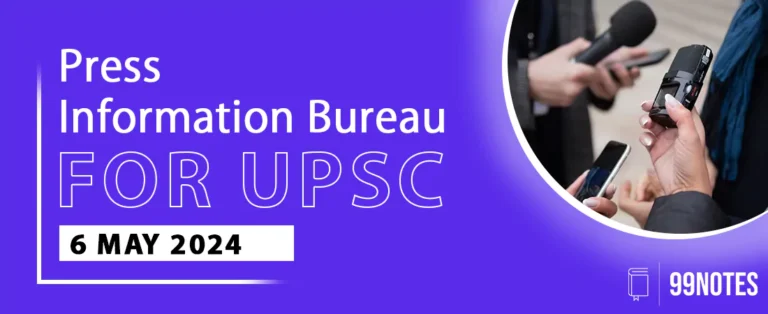SCIENCE REPORTER SUMMARY: NOVEMBER 2024
ARTICLE 1:
Discovery of two new species of molluscs in the the Bay of Bengal
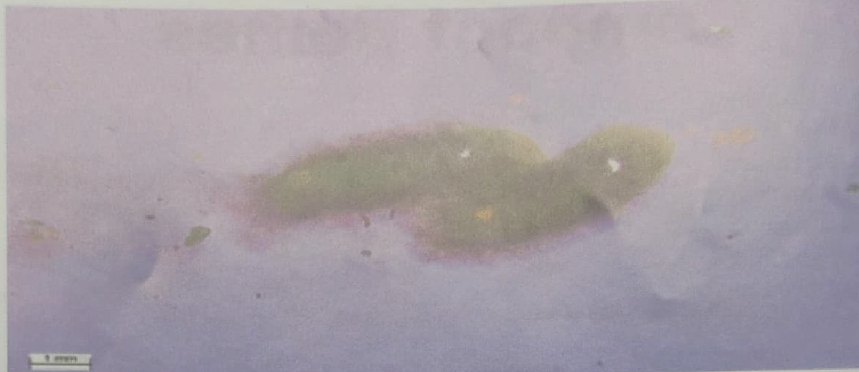
A Unique Find in Digha
- Dr. Prasad Chandra Tudu, a scientist from the Zoological Survey of India (ZSI), made an extraordinary discovery of a rare mollusc species in Digha, West Bengal.
- Named Melanochlamys droupadi to honor India’s President, Droupadi Murmu, this species is characterized by a distinctive ruby-red blotch on its back, reminiscent of a decorative bindi.
- Found on damp, soft-sand beaches, the mollusc is tiny, measuring only 7 mm in length and weighing around 8 mg.
- Exposed during low tide, it leaves behind a unique darker trail, which first caught Dr. Tudu’s attention.
Meticulous Documentation and Preservation
- Dr. Tudu followed strict scientific protocols to study and preserve the specimen. Using a Leica Stereomicroscope S9i, he photographed the mollusc and later relaxed and preserved it in ethanol after a careful process involving menthol crystals.
- This effort ensured adherence to the International Code of Zoological Nomenclature (ICZN) standards, making the naming scientifically legitimate.
- His findings were published in the Australian journal Molluscan Research and were acknowledged by President Murmu, highlighting the importance of conserving newly discovered species.
Importance and Challenges of Naming the Species
Honoring Notable Individuals
- Dr. Tudu emphasized the ecological significance of species conservation, noting that naming them after prominent figures like President Murmu raises awareness.
- The discovery of Melanochlamys droupadi brings the global count of mollusc species to 19, showcasing the biodiversity of India’s coastal regions.
Overcoming Scientific Hurdles
- The discovery journey was not without challenges. It took Dr. Tudu nearly a decade to establish his claims due to a lack of advanced facilities for DNA analysis at the Digha Centre.
- Initial samples were sent to specialized centers in Odisha and Kolkata for thorough testing. Despite these obstacles, his persistence paid off, leading to the identification of both Melanochlamys bengalensis in 2022 and Melanochlamys droupadi in 2024.
ARTICLE 2:
New Light on Dark Energy

Composition of the Universe
- The universe consists of three major components: ordinary matter, dark matter, and dark energy. Ordinary matter, which includes galaxies, stars, planets, and everything visible, makes up only 5% of the universe.
- In contrast, 25% consists of dark matter, and a staggering 70% is composed of dark energy. Despite their dominance, dark matter and dark energy remain largely mysterious.
- Scientists believe understanding dark energy could unlock secrets about the universe’s origin, evolution, and ultimate fate, as well as reveal new fundamental forces.
Discovery of Dark Energy
- The concept of an expanding universe traces back to 1922, when Russian scientist Alexander Friedman predicted it based on Einstein’s General Theory of Relativity.
- This was later confirmed in 1929 by American astronomer Edwin Hubble, who observed galaxies moving away from Earth. However, a groundbreaking discovery in 1998 revealed that the universe is not just expanding but doing so at an accelerated pace.
- This finding, made by Saul Perlmutter, Brian P. Schmidt, and Adam G. Riess, earned them the 2011 Nobel Prize in Physics. Observations of distant supernovae suggested an invisible force counteracting gravity, which was termed “dark energy.”
Understanding Dark Energy with DESI
- To investigate dark energy, scientists worldwide have been conducting extensive research, including the ongoing Dark Energy Spectroscopic Instrument (DESI) experiment.
- DESI is a state-of-the-art device mounted on the Mayall Telescope in Arizona. It can simultaneously capture light from 5,000 galaxies, allowing researchers to create a detailed 3D map of the universe.
- Using this instrument, scientists have measured light from six million galaxies, some dating back 11 billion years, and calculated that the universe’s expansion rate increases by 68.5 km/s for every 3.26 million light-years of distance.
Global Collaboration and Future Prospects
- The DESI project involves over 900 researchers from various countries, including India’s Tata Institute of Fundamental Research (TIFR). By mapping the universe and analyzing its expansion, the project aims to uncover the first clues about the nature of dark energy.
- With ongoing advancements and collaborations, scientists hope to unravel the mysteries surrounding this elusive force in the coming years.
ARTICLE 3:
21st Century Skills for Students future Success
Understanding Skills
Definition and Nature of Skills
- Skill refers to the ability to perform well due to training, experience, or practice.
- Unlike innate abilities such as memory or reasoning, skills like recalling information or problem-solving are acquired through learning and repetition.
- Proficiency in any skill improves with consistent practice, making repetition the foundation of skill mastery.
Types of Skills
Skills are broadly categorized into hard and soft skills.
- Hard Skills: These are job-specific and technical in nature, like mobile repairing, carpentry, or jewelry making.
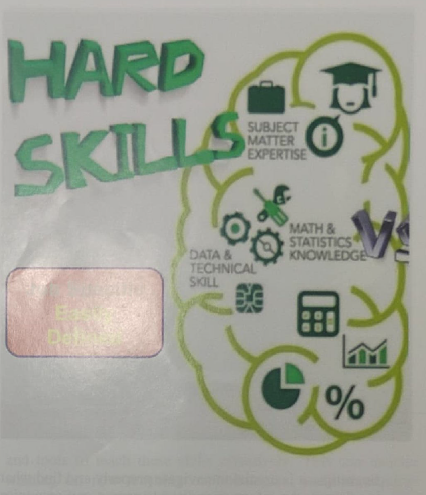
- Soft Skills: These include interpersonal abilities such as leadership, decision-making, and teamwork. In today’s world, a combination of hard and soft skills (a skill set) is essential for job success, enhancing productivity and competitiveness.
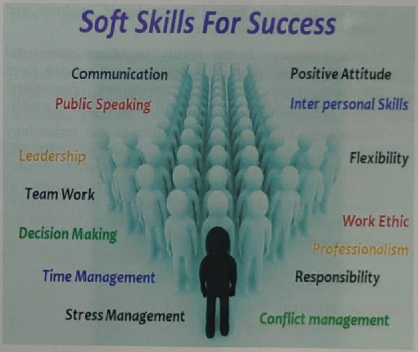
The Need for 21st-Century Skills
Adapting to a Changing World
- The 21st-century demands skills that go beyond traditional learning methods.
- These include critical thinking, communication, creativity, digital literacy, and global awareness.
- Such skills emphasize practical application and problem-solving, crucial for success in modern life.
Importance in Everyday Life
- Whether preparing for a career or navigating societal complexities, 21st-century skills like effective communication and adaptability are vital for achieving personal and professional goals.
Key Skill Categories
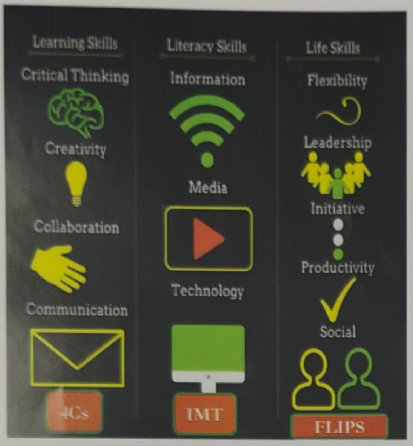
Communication Skills
- Effective communication involves clearly conveying ideas through speaking, writing, and listening.
- These skills are critical for building relationships, resolving conflicts, and succeeding in collaborative environments.
Literacy Skills (IMT)
- Information Literacy: The ability to locate, evaluate, and use information effectively.
- Media Literacy: Understanding and analyzing media content from various sources like the internet, TV, and newspapers.
- Technology Literacy: Utilizing technology tools responsibly and ethically to access, manage, and communicate information.
Life Skills (FLIPS)
- Flexibility: Adapting to changes with resilience and openness.
- Leadership: Motivating and guiding others toward common objectives.
- Initiative: Taking proactive steps and demonstrating eagerness to act.
- Productivity: Managing time efficiently to meet deadlines and achieve goals.
- Social Skills: Building healthy relationships and interacting harmoniously with society.
Challenges Without 21st-Century Skills
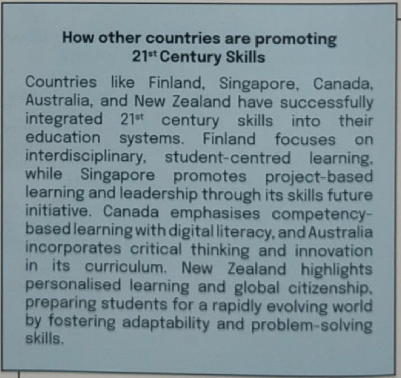
Academic Impact
- A lack of critical thinking and problem-solving skills can hinder students’ ability to analyze information and tackle complex challenges, leading to poor academic outcomes.
Career Readiness
- Inadequate technology literacy and adaptability can limit employability in a fast-evolving job market.
Social and Personal Development
- Poor communication and leadership skills can affect teamwork and personal growth, while the absence of cross-cultural awareness may lead to social isolation.
Integration of 21st-Century Skills into Education
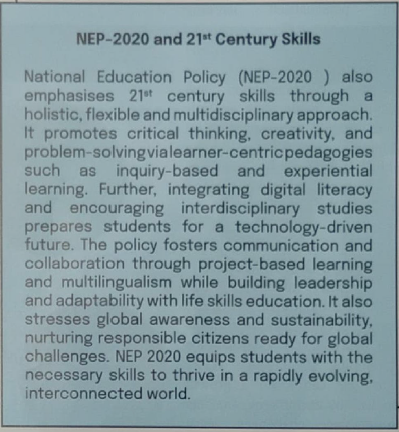
Curriculum Design
- Incorporating skill development into the curriculum through project-based and interdisciplinary learning fosters critical thinking, creativity, and collaboration.
Professional Development for Educators
- Training teachers in skill-based education equips them to integrate modern teaching methodologies and technology effectively.
Leveraging Technology
- Digital tools promote collaborative and personalized learning, enhancing critical thinking and communication.
- Thoughtful and ethical use of technology is essential in classrooms.
Fostering a Growth Mindset
- Encouraging resilience and a willingness to learn from mistakes helps students embrace challenges and persist in their efforts.
Social and Emotional Learning (SEL)
- Teaching students to manage emotions, set goals, and build relationships enhances emotional intelligence and interpersonal skills.
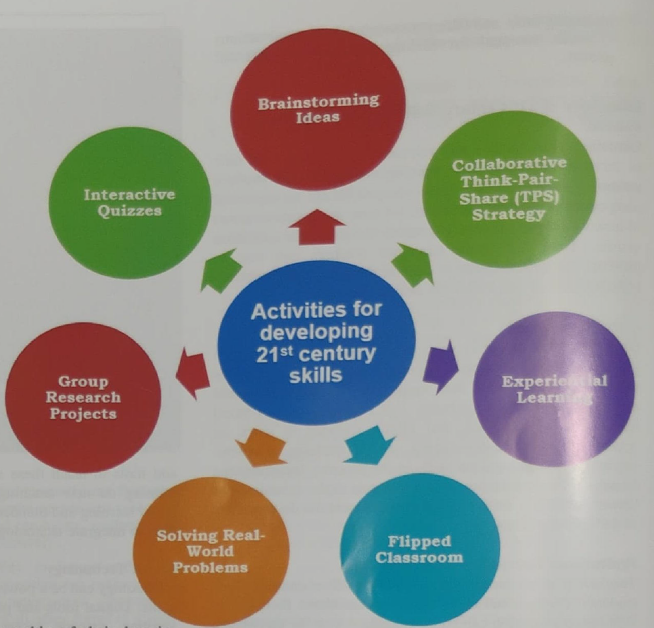
The Role of Education in Shaping the Future
- Building 21st-century skills prepares students to face real-world challenges, make informed decisions, and adapt to changes effectively.
- These skills are essential for leveraging India’s demographic advantage and ensuring success in personal and professional spheres.
- Experts emphasizes, integrating these skills into education from an early age can transform students into capable individuals, ready to contribute meaningfully to society and the workforce.
ARTICLE 4:
Anxiety in Children
The Growing Concern of Anxiety in Children
- Anxiety among children and adolescents has become a significant concern, as highlighted by working parents like Sachi, who worry about the impact of prolonged screen time on their children’s mental and physical health.
- According to the World Health Organization (WHO), one in seven adolescents globally suffers from mental disorders, with similar alarming statistics in India.
- Anxiety-related disorders manifest as stress, fear, and loneliness, affecting children of all age groups but predominantly teenagers.
Root Causes of Anxiety
Anxiety in children stems from a blend of genetic, neurological, and environmental factors. Key contributors include:
- Life Situations: Experiences like losing a loved one, abuse, or family conflicts can create deep-rooted fears.
- Social and Academic Pressures: Comparisons with peers, fear of judgment, and exam stress exacerbate anxiety levels.
- Technology’s Role: While digital engagement isn’t inherently harmful, excessive screen time is linked to increased anxiety.
Children with specific conditions, such as ADHD or autism, are at higher risk of anxiety disorders, further complicating the issue.
Recognizing Symptoms of Anxiety
Parents and educators must differentiate between developmental worries and persistent anxiety. Common symptoms include:
- Physical signs like nausea, headaches, and trembling.
- Emotional behaviors such as excessive worry, mood swings, or withdrawal.
- Specific disorders like Social Anxiety Disorder, Selective Mutism, and Panic Attacks, each presenting unique challenges.
Tackling Anxiety in Children
Parental Role
Parents play a vital role in managing anxiety. Key strategies include:
- Setting realistic expectations and avoiding overprotectiveness.
- Encouraging outdoor activities, teamwork, and resilience.
- Maintaining open communication to understand and address their child’s concerns.
Professional Interventions
- When self-help methods fall short, professional help like Cognitive Behavioral Therapy (CBT) can effectively address anxiety.
- CBT focuses on altering negative thought patterns and teaching coping mechanisms. In severe cases, medication might be considered alongside therapy.
The Power of Mindfulness
- Mindfulness techniques have emerged as effective tools in managing anxiety. Techniques like the “3-3-3 Rule” for younger children and the “5-4-3-2-1 Technique” for older kids help them focus on the present moment.
- Such practices empower children to manage their emotions better and build healthier coping mechanisms.
Conclusion
- Addressing anxiety in children requires a combination of awareness, proactive parenting, and professional intervention when necessary.
- Equipping children with tools to manage stress and fostering a supportive environment at home and school can help reverse the growing trend of anxiety-related issues, ensuring healthier and happier childhoods.
ARTICLE 5:
Screen Time and Sight
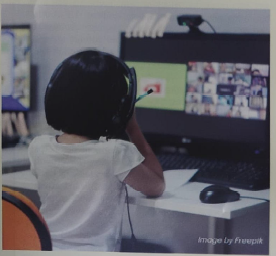
The Digital Age: A Double-Edged Sword
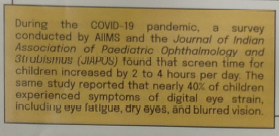
- In today’s technology-driven world, children’s screen time has dramatically increased. Smartphones, tablets, and computers are integral to education, entertainment, and communication, yet they pose significant risks to young eyes.
- According to AIIMS, Indian children spend an average of 6-8 hours daily on screens, a number that surged during the COVID-19 pandemic.
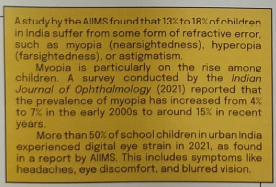
- Prolonged exposure to blue light from digital devices can lead to digital eye strain, characterized by symptoms like dryness, irritation, blurred vision, and headaches.
- These effects have contributed to a growing prevalence of myopia among children.
Understanding Digital Eye Strain
What is Digital Eye Strain?
- Digital eye strain, also known as computer vision syndrome, is a pressing health concern.
- Symptoms include frequent squinting, headaches, difficulty focusing, and occasional redness or watering of the eyes.
- Experts emphasizes the importance of regular breaks and outdoor activities to mitigate these issues.
- Also experts warns that children, particularly those under six, are more vulnerable to screen-related eye problems.
Why Does It Happen?
- Digital screens use pixels, which are less stable than printed text, causing eye muscles to work harder.
- The National Institute of Occupational Health links excessive screen time to blurry vision, dry eyes, and even neck pain.
- Blue light exacerbates the issue, affecting melatonin levels and disrupting sleep, which is vital for children’s growth and learning.
Early Detection and Preventive Measures
- Regular eye check-ups can help identify and address vision problems early, preventing adverse effects on learning and development.
- Experts recommend the first eye test at age three and subsequent examinations every two years.
- Protective eyewear during sports and proper lighting while reading can further safeguard eye health.
The Role of Nutrition in Eye Health
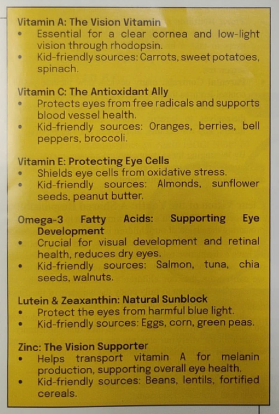
- Nutrition plays a critical role in maintaining healthy vision. Dr. Neelanjana Singh, a nutritionist, stresses the importance of a balanced diet rich in vitamins A, C, E, omega-3 fatty acids, lutein, and zeaxanthin.
- Foods like leafy greens, nuts, and seasonal fruits can help filter harmful blue light and reduce eye strain.
- Simple dietary changes can significantly impact children’s eye health.
Practical Tips for Protecting Young Eyes
- Follow the 20-20-20 Rule: Take a 20-second break every 20 minutes to look at something 20 feet away.
- Encourage Outdoor Activities: Spending time outdoors can reduce the risk of myopia and provide a healthy break from screens.
- Use Blue Light Filters and Night Mode: These reduce exposure to harmful blue light, promoting better sleep and eye health.
- Adjust Screen Settings: Proper brightness and contrast levels can minimize eye fatigue.
- Leverage Technology: Apps and parental controls can help monitor and limit screen time effectively.
Clear Vision for a Digital Future
- Protecting children’s vision is a shared responsibility. Parents, educators, health professionals, and policymakers must work together to ensure a healthy digital experience.
- By adopting proactive measures, we can help children enjoy the benefits of technology while safeguarding their eyesight.
- As Mahatma Gandhi said, “The future depends on what we do in the present.” Let us act now to ensure a clear and bright future for the next generation.
ARTICLE 5
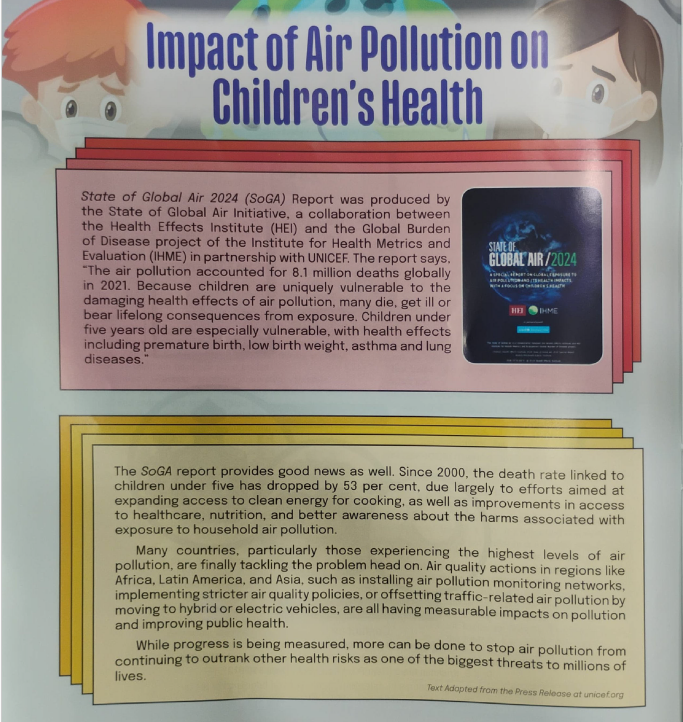
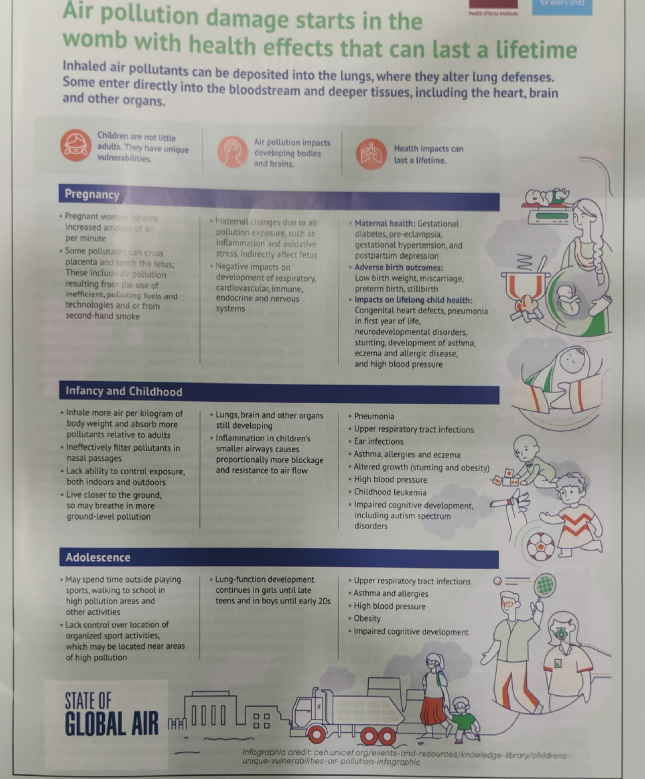
ARTICLE 6:
Bituminous Steel Slag Road, Building Sustainable Roads
- India’s steel industry, the second largest globally, generates 19 million tonnes of steel slag annually, with projections to reach 60 million tonnes by 2030. Steel slag, a byproduct of the steel manufacturing process, has traditionally been considered waste.
- However, its use in road construction has emerged as an eco-friendly and sustainable solution under the “waste-to-wealth” initiative.
- The Council of Scientific and Industrial Research-Central Road Research Institute (CSIR-CRRI) has been at the forefront of this innovative approach, leveraging processed steel slag aggregates to build durable and cost-effective roads.
Landmark Steel Slag Road Projects
1. Border Roads Organisation (BRO) in Arunachal Pradesh:
- BRO constructed a one-kilometre-long, heavy-duty road along the India-China border using 1200 metric tonnes of steel slag aggregates.
- This initiative demonstrated the potential of steel slag in developing resilient roads in challenging terrains.
2. Six-Lane Road in Surat, Gujarat:


- Surat became India’s first city to host a six-lane steel slag road, inaugurated in June 2022. Built as part of a collaboration between CSIR-CRRI, the Ministry of Steel, and NITI Aayog, the road utilized 1.9 crore tonnes of steel waste and replaced 100% of natural aggregates in its construction.
- This innovation resulted in a thinner yet stronger road capable of withstanding greater pressure and wear compared to conventional roads.
3. Steel Slag Road on NH-66:

- A four-lane steel slag road section was built on the Mumbai-Goa Highway using 80,000 tonnes of processed steel slag aggregates.
- Completed in January 2024, this road was inaugurated as a National Highway Steel Slag road section, marking a milestone in sustainable infrastructure development.
Environmental and Economic Benefits
- The use of steel slag addresses the unsustainable mining of natural aggregates, which often leads to environmental degradation and deforestation.
- Steel slag roads contribute to the circular economy by recycling waste into valuable construction materials, reducing reliance on virgin resources.
- Moreover, these roads have superior mechanical properties, including a high melting point (over 1200°C) and resistance to weather extremes, ensuring durability during sunlight, rain, and floods.
Challenges and Future Prospects
- While steel slag roads offer numerous benefits, their lifespan (approximately 15 years) is shorter than that of cement or concrete roads (30 years).
- However, their ability to withstand heavy loads and adverse conditions makes them a viable alternative.
- CSIR-CRRI is also exploring the potential of using steel slag in railway ballast, further expanding its applications in sustainable infrastructure.
A Step Towards Sustainable Development
- The innovative use of steel slag for road construction exemplifies India’s commitment to sustainable development.
- By transforming industrial waste into valuable resources, these initiatives reduce environmental impact, promote a circular economy, and set a precedent for future green technologies.
ARTICLE 7:
The Kakapo: A fascinating parrot on the verge of extinction
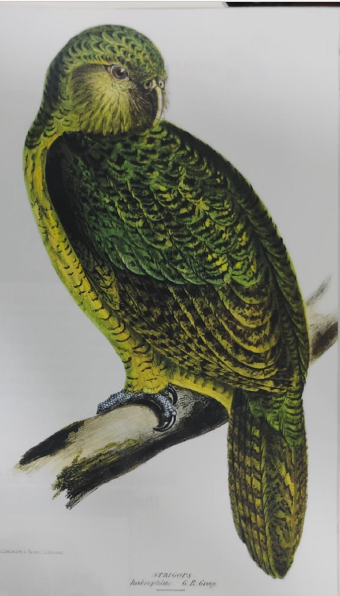
- The Kakapo (Strigops habroptilus), also known as the “owl parrot” due to its owl-like face, is a critically endangered, flightless parrot native to New Zealand.
- Weighing up to 4 kilograms, it is the world’s heaviest parrot. Its moss-green feathers enable it to camouflage seamlessly into forest surroundings.
- Nocturnal by nature, the Kakapo has a well-developed sense of smell that aids in foraging in the dark.
Unique Characteristics of the Kakapo
- Unlike most parrots, Kakapos cannot fly due to their lack of a keel on the sternum and relatively short wings.
- Instead, they use their strong legs and muscular build to traverse the forest floor and climb trees.
- Kakapos are solitary birds and exhibit a fascinating “lek” breeding system, where males gather to display and compete for the attention of females, who then choose their mates based on these displays.
Decline and Endangerment
- Once widespread across New Zealand, Kakapos now face severe threats, making them one of the most endangered bird species on Earth.
- Factors such as habitat destruction, predation by introduced species like rats, cats, and stoats, and human interference have drastically reduced their numbers.
Conservation Efforts
- To combat their decline, conservationists launched a recovery program that included relocating Kakapos to predator-free islands, breeding them in captivity, restoring their habitats, and close monitoring.
- These efforts have shown progress, with the Kakapo population gradually increasing.
- However, the species remains critically endangered, necessitating sustained conservation efforts to ensure its survival.
Lessons from the Kakapo
- The Kakapo symbolizes nature’s resilience and adaptability while reminding us of the consequences of human actions on the environment.
- Protecting this unique bird underscores the importance of conservation and preserving biodiversity for future generations.
NEWS IN BRIEF
1) A wearable brain imaging device

- Researchers at University College London (UCL), in collaboration with Gowerlabs, have developed a wearable brain imaging headgear for measuring brain activity in babies using light waves.
- This innovative technology enables the observation of activity across the entire outer brain surface beneath the scalp, allowing researchers to detect interactions and activity in previously unexplored areas.
- The findings were published in Imaging Neuroscience.
2) Researchers at IISc develop a supercapacitor that can be charged by shining light on it
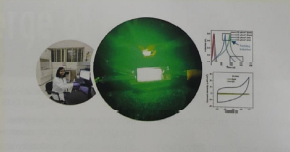
- Researchers at the Indian Institute of Science (IISc) and collaborators have developed a novel supercapacitor that can be charged using light.
- The supercapacitor’s electrodes are made of zinc oxide (ZnO) nanorods grown on transparent fluorine-doped tin oxide (FTO).
- This technology has potential applications in devices like solar-powered streetlights and sensors. The study was published in the Journal of Materials Chemistry.
3) ML-CASCADE — a tool to map landslide extent using satellite data
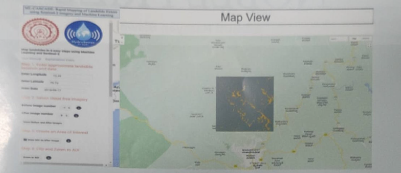
- Researchers at IIT Delhi have developed ML-CASCADE, a cloud computing and machine learning-based tool for rapid landslide mapping.
- Using Sentinel-2 data in Google Earth Engine, it maps landslides in as little as 2-5 minutes, aiding post-disaster damage assessment.
- The model leverages extensive satellite, terrain, vegetation, and soil data. Published in the Landslides journal, the tool has potential applications in mapping floods, deforestation, sand mining, and other environmental challenges.
4) Detect Blood Pressure using a smartphone

This innovation could make regular blood pressure monitoring more convenient and widely available.
Researchers at the University of Pittsburgh have developed a smartphone application to measure blood pressure, offering a cost-effective and accessible solution.
The app uses smartphone sensors to detect pulse pressure during a simple hand-raising motion.


